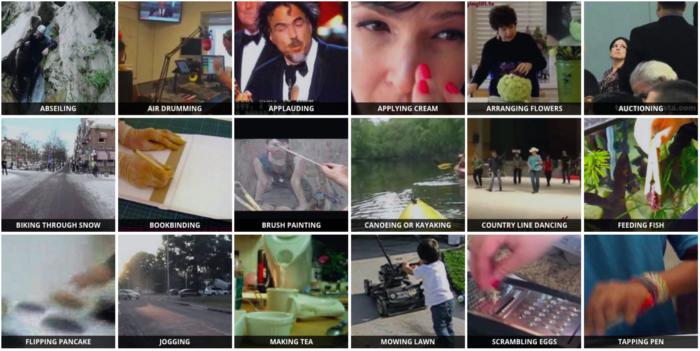Run ResNets on videos for action recognition.
We strongly recommend using a virtual environment. If you're not sure where to start, we offer a tutorial here.
pip install ikomiafrom ikomia.utils.displayIO import display
from ikomia.core import IODataType
from ikomia.dataprocess import CImageIO
from ikomia.dataprocess.workflow import Workflow
import cv2
# Init your workflow
wf = Workflow()
# Add object detection algorithm
detector = wf.add_task(name="infer_resnet_action_recognition", auto_connect=True)
stream = cv2.VideoCapture(0)
while True:
# Read image from stream
ret, frame = stream.read()
# Test if streaming is OK
if not ret:
continue
# Run the workflow on current frame
# We don't run at workflow level as action recognition algorithm need to accumulate frames
# and frame stack is cleared when a workflow is started
detector.set_input(CImageIO(IODataType.IMAGE, frame), 0)
detector.run()
# Get results
image_out = detector.get_output(0)
graphics_out = detector.get_output(1)
# Convert color space
img_res = cv2.cvtColor(image_out.get_image_with_graphics(graphics_out), cv2.COLOR_BGR2RGB)
# Display using OpenCV
display(img_res, title="Action recognition", viewer="opencv")
# Press 'q' to quit the streaming process
if cv2.waitKey(1) & 0xFF == ord('q'):
break
# After the loop release the stream object
stream.release()
# Destroy all windows
cv2.destroyAllWindows()Ikomia Studio offers a friendly UI with the same features as the API.
-
If you haven't started using Ikomia Studio yet, download and install it from this page.
-
For additional guidance on getting started with Ikomia Studio, check out this blog post.
-
model_name (str) - default 'resnet-18-kinetics': Name of the pre-trained model. Additional ResNet size are available:
- resnet-34-kinetics
- resnet-50-kinetics
- resnet-101-kinetics
- resnext-101-kinetics.onnx
- wideresnet-50-kinetics.onnx
-
rolling (bool) - default 'True': Number of frame passed has input.
-
sample_duration (int) - default '16': Number of frame passed as input.
If rolling frame prediction is used, we perform N classifications, one for each frame (once the deque data structure is filled, of course) If rolling frame prediction is not used, we only have to perform N / SAMPLE_DURATION classifications, thus reducing the amount of time it takes to process a video stream significantly.
Parameters should be in strings format when added to the dictionary.
from ikomia.utils.displayIO import display
from ikomia.core import IODataType
from ikomia.dataprocess import CImageIO
from ikomia.dataprocess.workflow import Workflow
import cv2
# Init your workflow
wf = Workflow()
# Add object detection algorithm
detector = wf.add_task(name="infer_resnet_action_recognition", auto_connect=True)
detector.set_parameters({
"model_name": "resnet-34-kinetics",
"rolling": "False",
"sample_duration": "16"
})
stream = cv2.VideoCapture(0)
while True:
# Read image from stream
ret, frame = stream.read()
# Test if streaming is OK
if not ret:
continue
# Run the workflow on current frame
# We don't run at workflow level as action recognition algorithm need to accumulate frames
# and frame stack is cleared when a workflow is started
detector.set_input(CImageIO(IODataType.IMAGE, frame), 0)
detector.run()
# Get results
image_out = detector.get_output(0)
graphics_out = detector.get_output(1)
# Convert color space
img_res = cv2.cvtColor(image_out.get_image_with_graphics(graphics_out), cv2.COLOR_BGR2RGB)
# Display using OpenCV
display(img_res, title="Action recognition", viewer="opencv")
# Press 'q' to quit the streaming process
if cv2.waitKey(1) & 0xFF == ord('q'):
break
# After the loop release the stream object
stream.release()
# Destroy all windows
cv2.destroyAllWindows()



